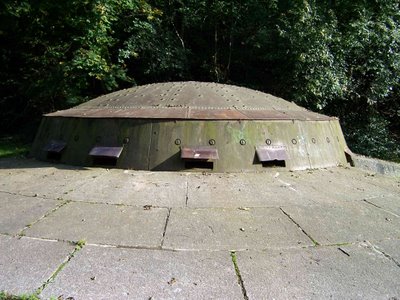The Ramparts of Strasbourg
 In Strasbourg it is all about diplomacy. Militarism and war are far out of sight and mind in the city of today. However, there are vestiges of a less peaceful past. This post is picking up where the last one left off.
In Strasbourg it is all about diplomacy. Militarism and war are far out of sight and mind in the city of today. However, there are vestiges of a less peaceful past. This post is picking up where the last one left off.In 1870, Strasbourg was still considered a substantial fortress on the Eastern frontier of France. The defenses constructed by Vauban had served the town well for 300 years or so...at least until August of that year when when the Prussians began their siege of the town. Soon it was obvious that the old walls couldn't stand up to the new technology.
When the walls were built, their task was to stand up to cannon balls being bounced against them from a distance of 500 yards or so. In August 1870, the Germans set up their new carbon steel Krupp artillery and lobbed shells from a mile or so away... over the wall into the heart of the town. Over 200,000 shells in total. The bombardment of Strasbourg was the humanitarian crisis of its day. It was not the first time that civilians were targeted in order to break the will of the army. But it foreshadowed that improving technologies of war would increasingly put the population centers in play and at risk.
Anyway, Germany won the war in 1871 and claimed Alsace and Lorraine as a prizes. One of the first things that the new conquerors did was to re-fortify Strasbourg as a frontier stronghold against the French. In the 1870s, they quickly rebuilt the city defenses to incorporate postitions for modern artillery and machine guns. They encircled Strasbourg with an "inner defensive ring".

Today, very little of the German-built defenses are visible. Much, it seems, was torn down when they built the major highways around the town. However, there is a section of the old wall that remains- beginning near Cronenbourg and extending behind the Strasbourg train station. The outward facing side of the wall looks like big tree covered hills. The areas around it are covered with walking paths and public vegetable gardens, as shown in the picture below.

In between the gardens, however, you can find pretty significant traces. The opening picture shows the Kriegstor (German for War Gate) that would have linked Strasbourg with Cronenbourg. (Kronenburg in those days...spelled the same as the beer.) The second picture shows a blinded gun emplacement, one of several that seem to be placed every few hundred yards apart.
The pictures below show the casements on the interior side of the wall. The casements provided storage for shells for the artillery positions on top of the wall or access to the blinded emplacments on the other side of the wall. The first picture below shows one of the casement doors with the construction date of 1878 appearing at left. The second picture shows one of the larger casements that is still used today as a depot by the local police. The third picture below shows the remains of a bastion...on top of which would probably been a battery of artillery pieces.



They Germans also realized that, to prevent a repeat of the 1870 bombardment, they needed to keep any invading army from getting close enough to Strasbourg to lob shells into it. Consequently, they designed an "outer ring" of detached forts to keep opposing forces at a safe distance. They built a dozen or so of these forts in a circle around the city. Some of them they built on the German side of the Rhine. The remainder on the French side. (If you are truly interested, then you can work your way through this French site dedicated to the forts.)
There is actually one of these detached forts, Fort Uhrich, about a mile or so away from the site where I work. It is abandoned and overgrown and you have to hike through the woods to find it. Most of these forts are forgotten and only seen on topographic maps. Or you can recognize them from the air by the tell-tale water works that encircle them, as shown by this example and this other example.

0 Comments:
Post a Comment
<< Home